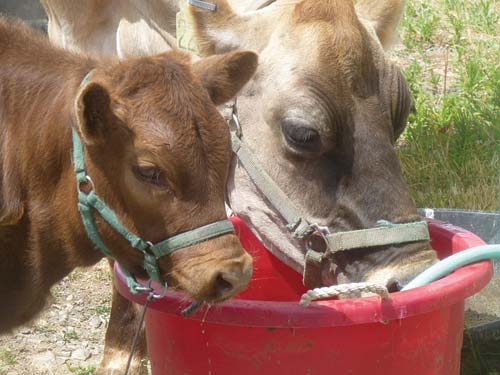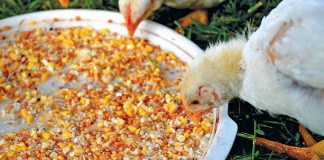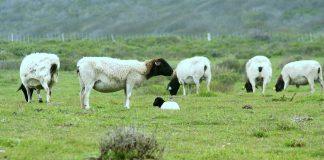 |
|
| Issue #137 • September/October, 2012 |
In 2009, small farmers and ranchers breathed a sigh of relief. So did people worried about another curtailment of individual liberty and those whose religious principles oppose microchipping.
They thought they had driven a stake through the heart of the National Animal Identification System (NAIS), a USDA-run, state-implemented, program whose goal was to microchip and track all livestock, right down to the smallest chick on the smallest farm.
But three years later NAIS has risen from the grave. Now the monster goes by a different name Animal Disease Traceability (ADT) and claims to be (cough) kinder and gentler. Don’t be fooled. ADT is at least as insidious as NAIS.
When I was asked to write this article, Backwoods Home’s editors requested I keep the ranting to a minimum and provide just the facts. Those instructions were merited because frankly it’s hard for a livestock owner to discuss the issue without frothing at the mouth. I have yet to hear from any small farmer, rancher, or homesteader who approved of NAIS or thought it was a good idea or even a feasible one. And we shouldn’t be much fonder of ADT.
I’m going to focus on the current threat, ADT; but a little background is in order, since the USDA’s proposal for ADT owes so much to the supposedly “dead” NAIS.

The background
The NAIS was conceived by the National Institute for Animal Agriculture (NIAA), a group that consists primarily of digital chip manufacturers and big corporate meat producers. Piggybacking on the fear caused by the twin threats of terrorism and mad cow disease (BSE), the NIAA thought up a brilliant plan: “Hey Charlie, let’s microchip every single livestock animal in America!”
Under NAIS, every owner of even one livestock animal (cattle, horses, sheep, goats, poultry, pigs, bison, deer, elk, and even some species of fish raised for aquaculture) would have been required to register their name, address, telephone number, and the Global Positioning System coordinates of the animal’s location with the federal government. Every individual animal in a small operation would have an implanted Radio Frequency Identification Device (RFID) bearing a 15-digit number. Large producers of pigs or poultry, on the other hand, were going to be allowed the advantage of grouping animals under one number.
The livestock owner would be required to report activities associated with the chipped animals. Not only major events like birth or death; if your ram jumped your fence, you would have had to report it to the government. Ride your horse off your property? Each ride would have to be reported. No exceptions.
There was more: heavy fines for non-compliance (up to $1,000 per day under proposed Texas regulations) and veterinarians would be required to report incidences of non-compliance if they find animals without ID numbers.
The stated goal of NAIS was to safeguard America’s meat supply against diseases by tracking every conceivable livestock animal. This detailed control on potential disease vectors would, in turn, soothe the fears of export markets
In reality, of course, the implementation was a nightmare, both logistically and in terms of property rights and privacy. Additionally, it was clear from the start that the major beneficiaries were the large producers, and that small farmers and ranchers would be unfairly impacted.
Thankfully, in June 2009, federal funding for NAIS in its original form was dropped from the fiscal 2010 spending bill by the House Agricultural Appropriations Subcommittee. House leaders indicated no future funds would be available unless the USDA one day made NAIS mandatory.
Instead, the USDA abandoned NAIS. Some funding was kept to maintain the program in places where it was already being implemented, such as in Wisconsin, but the rest of the program was effectively dismantled. Some (myself included) naïvely assumed that the USDA had backed down from such an intrusive program because of the opposition.
We were unaware that something new and just as insidious was up the USDA’s sleeve.
Son of NAIS
In August 2011, the USDA unveiled a program called Animal Disease Traceability (ADT). It is a scaled-down version of NAIS.
“After concluding our listening tour on the National Animal Identification System in 15 cities across the country,” said Agricultural Secretary Tom Vilsack, “receiving thousands of comments from the public and input from states, tribal nations, industry groups, and representatives for small and organic farmers, it is apparent that a new strategy for Animal Disease Traceability is needed.”
In other words, the USDA couldn’t take “No” for an answer and decided to implement a nationwide livestock-tracking program after all. Some of the supposed improvements of ADT over NAIS are: it applies only to animals moved interstate; it will be run entirely by state and tribal governments to provide more flexibility; it will use low-cost technology; and it will be implemented transparently through federal regulations and the full rulemaking process.
Doubtless recalling the fierce opposition toward NAIS, Secretary Vilsack said, “One of my main goals for this new approach is to build a collaborative process for shaping and implementing our framework for Animal Disease Traceability … and giving ample opportunity for farmers and ranchers and the public to provide us with continued input through this process.”
Part of this input included an advisory committee which, as expected, was industry-dominated; but at least it included representation from small farmers and ranchers. It must be emphasized that this committee was advisory only; the USDA is not obligated to accept any of its recommendations.
One of the members was attorney Judith McGeary, Executive Director of Farm & Ranch Freedom Alliance (www.farmandranchfreedom.org). FARFA is a non-profit organization headquartered in Texas with members in 45 states. The group advocates for farmers, ranchers, and homesteaders through public education and lobbying. Its goal is to assure their independence in the production and marketing of food and to prevent imposition of unnecessary regulatory burdens.
To learn the latest information on the Animal Disease Traceability program, I spoke to Ms. McGeary at length.
“The proposed rule is a solution in search of a problem,” she said. “The USDA has failed to identify the specific problem or disease of concern, and the real focus of the program is helping the export market for the benefit of a handful of large corporations.” (It’s important to note that for all the massive increases in cost, bureaucracy, paperwork, and loss of independence, this government intrusion would be implemented despite only four cases of BSE having been reported in the United States. And BSE has never occurred on grass-fed or organic meat operations, the kinds of operations most often associated with small and medium-sized producers.)

FARFA’s objections and recommendations
FARFA lodged its opposition to ADT on many points:
First, ADT’s costs significantly outweigh its benefits. The USDA has failed to provide scientific support justifying these new regulations. Traceability is an unproven approach, particularly in light of the success of tuberculosis and brucellosis vaccination programs. When FARFA submitted a very specific list requesting solid facts and data to support the need for Animal Disease Traceability, the majority of the questions remained unanswered (which sounds either like a case of “We really don’t have the answers for that” or maybe even “If we ignore them they’ll go away”).
Second, FARFA maintains that the agency’s Regulatory Impact Analysis is significantly flawed and fails to properly address the costs of the proposed rules.
It’s an understatement that government agencies routinely and severely underestimate the costs and impact on those who are regulated. ADT is no exception. The agency is “encouraging the use of lower-cost technology” such as electronic ear tags, but the infrastructure and labor necessary to place tags on livestock is not as simple as it sounds. Range cattle are large, ornery, and generally not in the mood to be subdued in a chute and tagged. Indirect costs associated with this ruling may include the purchasing or construction of chutes, hiring additional labor, legal requirements to sale barns and veterinarians, vet charges and farm calls, and even increased insurance requirements for labor. This doesn’t even address the cost to the taxpayers for hiring personnel to manage an enormous computerized database of information.
The vast bulk of the cost associated with compliance will not fall on those who benefit the most from implementation. The costs will be born by producers and associated businesses (such as sale barns and veterinarians), but the benefits will be reaped by exporters and digital chip manufacturers because, yes, the ear tags and leg bands favored under the current version of ADT contain NAIS-style RFID chips.
Third, FARFA believes many aspects of livestock production should be exempt. For instance, feeder cattle (cattle under 18 months of age) and poultry should be excluded to avoid harming producers and sales barns and to avoid problems like the impossible burden of having to band, re-band, and re-band birds and report each banding as their legs grow. Banding adult birds and obtaining Interstate Certificates of Veterinary Inspection (ICVIs) would likely cost more than the value of the bird. Dairy cattle should be better defined and those in small operations should be exempted and rules concerning horses should be simplified and made more clear. Currently, the ADT could be interpreted to mean that horse owners would have to get permission from every single state an animal passes through on the way to a rodeo or horse show.
FARFA also wants brands and tattoos officially recognized forms of identification, subject to states’ abilities to opt out. The proposed rule “downgrades brands to an unofficial form of identification,” notes Ms. McGeary. “Yet producers in brand states know that branding is an extremely reliable method for identifying animals.” And unlike ear tags, brands and tattoos are things an animal can’t lose. Additionally, removing brands and tattoos as official forms of identification could have ramifications on the legal and practical status of the animal. Also, FARFA maintains that cattle moving directly to slaughter should be identified with backtags, not ear tags. Backtags reduce stress on the animals, speed up efficiency, reduce hazards to workers, and cost less.
FARFA also suggested that the USDA reduce the record-keeping requirements to avoid imposing undue burdens on producers, veterinarians, state officials, and sale barns.
The proposed justification for the extra paperwork does not hold up under examination in “real world” situations. Vets and livestock sale barns would be required to keep records on cattle for five years, even though most of the cattle being documented will have already been consumed long before. This would create mountains of useless paperwork.
Costs to producers for veterinary services are likely to rise as well, since vets will need to pass the additional costs of regulatory paperwork on to the producers. And vets who specialize in large-animal care are already in short supply. (Trust me on this.)
Additionally, keep in mind one critical factor: Livestock owners who duck under the radar and refuse to tag their animals are far less likely to seek veterinary care when they encounter a health problem, because vets may be required to report them for noncompliance. The livestock owners could be subject to unspecified penalties. Clearly this is counterproductive if the USDA’s intent is to control disease.
FARFA also wants standards for using more than one form of official identification to be consistent and reasonable. Currently the proposed rule would prohibit prohibit! multiple official identification devices or methods on the same animal (with certain exceptions).
Personally, I find this extraordinary; and it demonstrates that those making the ruling are unfamiliar with the hands-on realities of livestock. The proposed ruling gives preference to electronic ear tags; but ear tags can be lost on a regular basis (trust me on this). That’s why additional identification such as brands and tattoos should be recognized and maintained.
FARFA identified many other problems. For instance, the proposed rule defines livestock as “all farm-raised animals.” Clearly this is vague and open to problems of interpretation. What about livestock (such as chickens or goats) raised in urban environments? What about farm-raised dogs bred for sale? Don’t laugh; these are serious issues that require specific definitions.
Finally, FARFA recommended that the proposed rule not be adopted at all until performance standards and evaluations have been determined.
“In effect,” notes FARFA, “the agency is asking producers to provide it with a ‘blank check,’ signing on to a program when the consequences are unknown. That blank check could be expensive. The agency has not accurately evaluated all of the direct and indirect costs of the proposed rule to producers and sale barns, such as the costs in time and potential injuries to both people and animals. In addition, the costs to States remain unknown, an issue of deep concern at a time when many State agencies are facing dramatic cuts to their budgets.”

Put on the brakes
Bottom line, FARFA is urging the USDA to identify the specific diseases of concern and analyze how to best address those diseases (including prevention measures) rather than continuing to push a one-size-fits-all tracking program with numerous built-in problems.
And remember, it’s not the small producers who are the problem children in the food supply chain. It’s the huge agribusinesses who deal with large numbers of animals in filthy disease-ridden conditions that are of greater concern. If the export market would benefit from the proposed rule, as the agency claims, then the packing companies that export meat should pay the costs and offer economic premiums to livestock producers to encourage them to participate in a voluntary system. Rather than forcing homesteaders and small farmers and ranchers into compliance with an untested tracking system, the USDA would do better to improve preventative measures in agribusiness facilities rather than after-the-fact tracking.
FARFA is urging the USDA not to rush into something badly-written, vague, intrusive, and unrealistic. It is asking the USDA to withdraw the proposed rule until further studies and data have been compiled, and a complete cost analysis can be conducted for all parties affected, including those who were essentially overlooked in the current analysis (such as backyard poultry owners, pastured poultry farmers, vets, sales barns, and overburdened state agencies).
So who’s in favor?
With all the legitimate concerns and objections from small farmers and ranchers, who on earth is in favor of this proposed ruling? Needless to say, we need look no further than the big corporate agribusinesses.
Since Animal Disease Traceability, like NAIS, is meant to soothe the concerns of foreign export markets, the large meat producers and meat packers are strongly urging its passage. “The powerful meatpacking lobby has continued to push for such mandated traceability requirements in order to develop international standards for exports,” notes FARFA. “Critics have suggested this is not in the American public’s best interest, however, since the U.S. is a net importer of beef and cattle and the profits from the export market go to a small handful of massive meatpacking companies … The extra expenses and labor will fall disproportionately on family farmers and ranchers, accelerating the loss of independent businesses to corporate industrial-scale producers.”
“Consumers need the USDA to start focusing on the animal health and food safety risks posed by industrialized meat production,” said Patty Lovera of Food & Water Watch. “If USDA devoted as much energy to preventing animal diseases as it has to promoting animal tracking, our food system would be in much better shape.”

Just say no
As with NAIS, ADT will benefit the few at the expense of the many. Additionally, it appears to be a transparent attempt to bully, strong-arm, and regulate small farmers and ranchers out of existence to “erode competition in the marketplace,” to phrase it more nicely in favor of the huge corporate meat producers. “The new program,” notes McGeary, “is most definitely mandatory. They’re not going through the pretense of calling it voluntary this time [as they did with NAIS].” More importantly, it fails to resolve the very problems it purports to address. As one frustrated commenter put it, “What part of ‘NO’ is beyond your comprehension?”
With regards to sheep, goats, and hogs, the proposed rule would take existing programs (most of which are mandatory) at the state level and make them mandatory at the federal level. When it comes to cattle and poultry, the proposed rule creates a whole new set of mandatory requirements since there currently are no state requirements for tagging feeder cattle or tagging individual chickens.
“Food safety” and increasing regulations have become the universal catch-phrase. After all, who can object to making our food sources safer? But ADT targets the wrong producers and uses the wrong solutions. Since the program applies when animals cross state lines, many small farmers might not be called upon to comply since they don’t often ship their animals directly. (Poultry would be the exception, given how many small-scale poultry owners receive baby chicks from out-of-state hatcheries).
But that is not to say that small farmers won’t feel the pain of ADT.
The record-keeping burdens placed on sale barns and livestock vets make it likely that some will either go out of business or stop dealing with small producers, leaving these operations without critical infrastructure support. We’ll see small farmers being pressured from multiple directions, even if they never are out of compliance with the new rule.
Most urban people are not aware of ADT for the simple reason that it doesn’t affect them personally. They don’t own livestock. But take away their ability to purchase organic and/or grass-fed meat from small farms, and they’ll start to care soon enough. This nation’s small producers are tired of dealing with expensive and unnecessary regulations and bureaucracy for imaginary problems. And consumers want the choice of where to buy their food.
One thing is certain: We are battling for individual freedom, even to the level of what we consume. Producers and consumers alike are simmering with anger over such unconstitutional atrocities as killing pigs on farms (as the state of Michigan recently forced owners of heritage breeds to do) and arresting Amish farmers at gunpoint for selling raw milk to willing buyers. These battles may come to a head at some point.
What is very likely to happen is ADT will be widely ignored by homesteaders and small farmers either for financial reasons, or for reasons of independence and privacy. In short, ADT will become another excuse for the government to prosecute small farmers (as is currently happening with raw milk farmers). By refusing to comply with ADT, small farmers and ranchers will be leaving themselves vulnerable to prosecution by petty government bureaucrats.
Current status
As of this writing, the window for commenting on the ADT program is closed, and the USDA has written the final form (which no one has seen) and has sent it to the Office of Management and Budget (OMB). The OMB has 90 days to respond and will publish the final rule in late summer. Sometimes things get hung up with the OMB, so although the final decision is expected by late summer, there’s no guarantee. At this point no one knows what’s in it or what to expect.
What we do know is that the USDA is trying to fix a system which ain’t broken; or, more likely is trying to impose a new system to break small and medium farmers, ranchers, and freedom-loving homesteaders.
I am heavily indebted to Judith McGeary, Esq., of the Farm and Ranch Freedom Alliance (www.farmandranchfreedom.org) for her invaluable assistance in the writing of this article.
Partice Lewis has more to say at www.rural-revolution.com.















Thank you for the article. I did not support the NAIS, I let people know about it. I don’t think ADT is any better. (Thought the government was suppose to be getting smaller, with this administration.) I have lost confidence with the USDA, seeing this article, I feel that I won’t be seeing it anytime soon. Who do I need to start talking/writing to let ’em know I am not liking this ADT?
Thank you for informing us all.